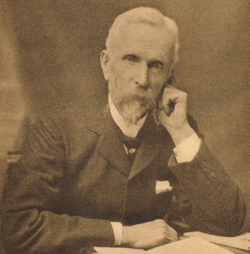John Aitken (meteorologist) facts for kids
Quick facts for kids
John Aitken
FRS FRSE
|
|
|---|---|
 |
|
| Born | 18 September 1839 |
| Died | 14 November 1919 (aged 80) |
| Nationality | Scottish |
| Alma mater | Glasgow University |
| Known for | cloud physics aerosol |
| Awards | Keith Prize 1883-5 Gunning Victoria Jubilee Prize 1893-6 Royal Medal (1917) |
| Scientific career | |
| Fields | meteorology and physics |
| Institutions | Practised meteorology from his home at Darroch, Falkirk. |
| Signature | |
 |
|
John Aitken (born September 18, 1839 – died November 14, 1919) was a smart Scottish scientist. He was a meteorologist, which means he studied weather and the atmosphere. He was also a physicist and an engineer. John Aitken helped start the study of how clouds form and how tiny particles in the air behave. He even built the first tool to count dust and fog particles in the air, called a koniscope.
Contents
About John Aitken
John Aitken was born in a town called Falkirk, Scotland, on September 18, 1839. He was one of eight children. His father was a lawyer.
John went to Falkirk Grammar School. Later, he studied marine engineering at Glasgow University. He also trained to be an engineer with a shipbuilding company in Glasgow.
After his studies, he moved back to his hometown of Falkirk. There, he did many of his important science experiments.
Awards and Recognition
In 1875, John Aitken became a member of the Royal Society of Edinburgh. This is a famous group of scientists in Scotland. Important scientists like William Thomson, Lord Kelvin supported him.
He also became a member of the Royal Society of London in 1889. This is another very important science group. In 1917, he won the Royal Medal from this society. He also received other awards, like the Keith Medal and the Gunning Victoria Jubilee Prize. In 1902, he received an honorary degree from the University of Glasgow.
John Aitken passed away in Falkirk on November 13, 1919.
What John Aitken Discovered
John Aitken did many experiments about dust in the air. He studied how this dust helps clouds and fog form. He also researched how dew forms and the rules of cyclones.
Counting Air Particles
He invented a special tool to count the tiny dust particles in the air. This tool helped many scientists who came after him. He also created better designs for thermometer screens. These improvements helped meteorology, which is the study of weather.
One of his experiments showed for the first time how new tiny particles form in the atmosphere. He wrote about this work in an article in 1898. The article was called "On some nuclei of cloudy condensation."
Dust, Fogs, and Clouds
John Aitken made several important discoveries about "Dust, Fogs and Clouds." He wrote an article with this title in 1880. As early as 1874, he realized something important. When water vapor in the air turns into liquid (condenses), it needs a tiny solid particle to stick to. This means that without dust or other tiny particles in the air, clouds, fog, or rain would not form!
In 1884, he also figured out why sunsets often have such bright colors. He discovered that these colors are caused by sunlight bending around tiny dust particles high up in the atmosphere.
Today, scientists who study the atmosphere call the smallest air particles "Aitken nuclei." These are particles with a radius smaller than 0.1 micrometers. This size includes the newly formed particles that Aitken first showed existed.
See also
- Breath-figure self-assembly

